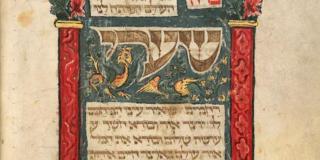
Don Ferrante Maḥzor
Unknown creator
Don Ferrante Maḥzor
Manuscript on vellum
[Kingdom of Naples], ca. 1458–95
This magnificent manuscript of an Italian medieval maḥzor (festival prayer book) of the 15th century includes a Haggadah section for the Passover holiday readings. On display is a page with an illustration of an olive tree to symbolize the word maror (bitter herbs). Here, maror represents the bitterness of Egyptian oppression.
While the names of the three scribes who contributed to creation of the manuscript are unknown, their styles are quite distinctive. The scribe who copied the Haggadah section (seen here) used red ink to emphasize initial words and essential phrases. The same scribe also left a blessing to Don Ferrante, or Ferdinand of Aragon (1423–1494), who ruled as King of Naples and Jerusalem from 1458 until his death. The manuscript became historically known as the Don Ferrante maḥzor thanks to this acknowledgment. Remarks left by another scribe refer to the Italian town of Correggio, thus identifying the region of Emilia-Romagna in Italy where the maḥzor was likely used.
The businessman and philanthropist Louis M. Rabinowitz (1887–1957) purchased this vellum manuscript from the Jewish community of Padua for his private collection. He donated the manuscript to the Library in 1952.
This object can be displayed in an image on the exhibition website. Use the Official Image field to upload an image. Use the Copyright Status as the Official Image Rights Statement. If present in your search result, Use the Copyright Notice as the Official Image Copyright Notice.






